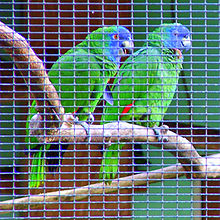Red-necked amazon
| Red-necked amazon | |
|---|---|
 |
|
| At the Parrot Conservation and Research Centre Botanical Gardens, Roseau, Dominica | |
| Scientific classification | |
| Kingdom: | Animalia |
| Phylum: | Chordata |
| Class: | Aves |
| Order: | Psittaciformes |
| Family: | Psittacidae |
| Genus: | Amazona |
| Species: | A. arausiaca |
| Binomial name | |
|
Amazona arausiaca (Muller, 1776) |
|
| Synonyms | |
|
Amazona bouqueti |
|
Amazona bouqueti
The red-necked amazon (Amazona arausiaca), also known as the red-necked parrot, Dominican blue-faced amazon, lesser Dominican amazon, and Jaco parrot, is an amazon parrot endemic to Dominica.
It is green, with bright splashes of various colours. Its name is due to the area of red plumage commonly found at its throat.
The hypothetical Martinique amazon ("A. martinicana"), known only from old descriptions, was said to look quite similar and may have been a related or even the same species. It was said to occur one major island to the south of Dominica.
The red-necked amazon gets its name because of its orange and reddish feathers found on its lower throat.
The bird also sometimes has blue feathers on its forehead, around the eyes and its head. Although, the blue feathers verge to wither away to gray feathers at its upper breast.The rest of its body is covered in deep bottle green feathers and a wide band of yellow color runs down to the tip of its tail. The beak and feet are both grey.These birds average about 40 cm in length and can weigh between 550 and 650 g.
The red-necked amazon is only found in the Caribbean island of Dominica. It lives throughout Montane and sub-montane forests of Morne Diablotion and Northern and Central Forest Reserves and sequestered State Lands that are above 1500 ft elevation.
This species also lives at subordinate altitudes in agricultural regions and peripheral forests all the way to the northwest and northeast coasts. The Jacos primarily eat flowers, sprouts, seeds and fruits of the rainforest trees and plants, citrus and pastoral crops.
With a population of less than 400 birds, this beautiful parrot is very endangered due to its habitat destruction and hunting.
The species is highly social and flies in groups of 30 or more during the non-breeding season. Exceedingly territorial during nesting, breeding inaugurates from January to March, with fledging from May to July.
Red-necked amazon pairs are loyal to each other and tend to stay at the same nesting site for many years. Other than early morning and afternoon calls, these birds are fairly quiet and difficult to detect in the wild because they are well cloaked by their fluff. They are dexterous climbing birds and are prone to migrate seasonally, provisional on food supplies.
...
Wikipedia

